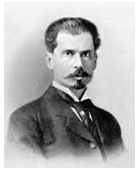Sergei Winogradsky was a Ukrainian-Russian microbiologist, ecologist and soil scientist who was among the first to delve into a different area of microbiology that involved the investigation of microbes in the environment that did not cause disease. Winogradsky pioneered the concept of bacteria (like nitrifying and purple-sulphur bacteria) that cycle nitrogen and sulphur compounds in the environment.
He discovered the first known form of lithotrophy during his research with a bacterium called Beggiatoa in 1887, and reported that Beggiatoa oxidized hydrogen sulfide (H2S) as an energy source and formed intracellular sulfur droplets. Winogradsky showed in his work that certain bacteria are linked to specific biogeochemical transformations, and this provided the first example of lithotrophy, but not autotrophy.
His studies on sulphur-oxidizing bacteria proposed the concept of chemolithotrphy, which is the oxidation of inorganic compounds linked to energy conservation. Sergei Winogradsky was one of the first to isolate microorganisms responsible for the conversion of elements like nitrogen and sulphur in the soil, and obtaining pure cultures of bacteria capable of oxidizing ammonia to nitrate.
Winogradsky also studied the consumption of hydrogen sulfide gas by sulfur-oxidizing bacteria directly in their natural habitat. He showed that nitrifying bacteria obtained their carbon from carbondioxide (CO2), and like phototrophic organisms, that nitrifying bacteria were also autotrophs.
References
Barrett J.T (1998). Microbiology and Immunology Concepts. Philadelphia, PA: Lippincott-Raven Publishers. USA.
Salyers A.A and Whitt D.D (2001). Microbiology: diversity, disease, and the environment. Fitzgerald Science Press Inc. Maryland, USA.
Slonczewski J.L, Foster J.W and Gillen K.M (2011). Microbiology: An Evolving Science. Second edition. W.W. Norton and Company, Inc, New York, USA.
Summers W.C (2000). History of microbiology. In Encyclopedia of microbiology, vol. 2, J. Lederberg, editor, 677–97. San Diego: Academic Press.
Talaro, Kathleen P (2005). Foundations in Microbiology. 5th edition. McGraw-Hill Companies Inc., New York, USA.
Wainwright M (2003). An Alternative View of the Early History of Microbiology. Advances in applied microbiology. Advances in Applied Microbiology, 52:333–355.
Willey J.M, Sherwood L.M and Woolverton C.J (2008). Harley and Klein’s Microbiology. 7th ed. McGraw-Hill Higher Education, USA.
Discover more from #1 Microbiology Resource Hub
Subscribe to get the latest posts to your email.



